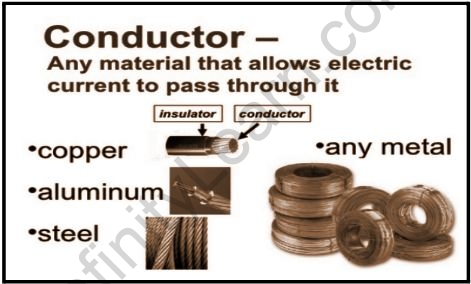Table of Contents
A conductor is a material or object that allows charge (electric current) to travel in one or more directions. Metals are commonly used as electrical conductors. The movement of negatively charged electrons, positively charged holes, and, in some situations, positive or negative ions generates an electric current. It is not essential for one charged particle to move from the component creating the current (the current source) to those absorbing it in order for current that flows within a closed electrical circuit (the loads).
A brief outline
Metals, metal alloys, electrolytes, and non-metals like graphite and conductive polymers can all be used as electrical conductors. These materials make it easy for electricity (or charge flow) to pass through them. The electrical conductor atom’s material can have no energy gap among its valence and conduction bands.
The valence band’s outer electrons are loosely linked to the atom. An electron goes from the valence band to the conduction band when it is stimulated by electromotive force or heat influence.
The conduction band is the region of the conductor where this electron is free to move about. A conductor is made up of atoms. As a result, the conduction band as a whole has an abundance of electrons.
Important concepts
The fact that metals are good conductors of electricity is due to a variety of circumstances. One of the most important is the existence of free electrons in metals, which aid in metallic bonding and hence qualify them as good electrical conductors. Because the constituent electrons of an atom are held loosely, metals can lose electrons. They have high conductivity and low resistance. They are good electrical conductors because they have a matrix of atoms with unbound electrons.
The following are the main characteristics of electrical conductors:
- A conductor always permits electrons or ions to travel freely.
- To allow electrons or ions to travel through a conductor, the electric field inside the conductor must be zero.
- The charge density inside a conductor is zero, which means that the positive and negative charges cancel out.
- Because there is no charge within the conductor, just free charges can dwell on the conductor’s surface.
- The electric current is perpendicular to the conductor’s surface.
Best conductors of electricity
Silver
Pure silver is the best electrical conductor, yet it is not among the most regularly used metals for conducting electricity. The widespread use of sterling silver has a few disadvantages. First, metal tarnishes with use, causing problems with the skin effect,’ which is the uneven distribution of current that really can occur across high voltage. The second disadvantage is the most obvious: running silver wire through a building is substantially more expensive than running aluminum or copper cable.
Copper
Copper is amongst the most often utilized metals for electrical conductivity. Copper is a malleable substance that is light to carry or solder, making it the perfect choice for huge volumes of wiring. Copper’s main grid function is in the distribution and generation of electricity. Motors, generators, transformers, and bush bars also just do it. It is the best and safest metal for producing power when correctly installed.
Aluminum
Aluminum is another metal with a strong electrical conductivity. Aluminum does have the electrical current-carrying capability of two pounds of copper, although its conductivity is only 60% that of copper by volume. As a reason, it is a very cost-effective substance, and it has progressively supplanted copper for various electrical purposes.
Gold
Gold has high conductivity, but due to its high price, it is only used in moderation. Microchips may include gold wires for connections, and very thin gold plating is utilized in applications that require strong corrosion protection as well as high conductivity. Whenever it pertains to metal alloys, their intrinsic features can help the main metal perform better in areas like strength, durability, weather resistance, and electrical applications.
Steel is an inflexible metal that is very corrosive if exposed to air. It is an alloy of iron that is also a conductor. Steel is used to encapsulate other conductors or for massive structures since it is hard to cast and is not employed in small products or equipment. Brass, like other alloys, is a tensile metal that is easy to bend and mold into various parts for tiny machines. It is less corrosive than steel, somewhat more conductive, less expensive to buy, and preserves its worth after usage, whereas steel alloy is really only profitable when purchased.
Worst conductor of electricity
Stainless steel
Stainless steel grades have vital electrical uses despite their lack of electrical conductivity. Because of their greater corrosion resistance, Type 304 and Type 316 are the most often utilized grades in the electrical industry. Stainless steel is used to create electrical casings for wall-mounts, floor-mounts, and freestanding junction boxes.

Significance of conductors in NEET exam
For all subjects, Infinity Learn’s answers for the NEET test are accessible provided by qualified teachers. They attempt to interpret any topic into manageable chunks. They began by discussing the main context and providing an overview with examples. Then they presented all of the crucial questions and answers, which students were able to answer quickly in the exam. Sentences are quite well, grammatically competent, and written in a simple manner. There is also a terrific attempt to clear any concerns related to doubts on the Infinity Learn website. Experts are always on hand to assist students with their questions.
Frequently Asked Questions
What is the term of the reverse of conductance?
Resistance is the inverse of conductivity.
State True or False: Electric lines are built of copper wires because metals are able to conduct electricity.
Accurate. Metal wires are being used to construct electric cables since they are outstanding conductors of electricity.
Make a list of some of the most prevalent insulators.
Insulators include things like glass, plastic, and air.
Is wood an excellent conductor of electricity or a poor conductor?
Electricity does not conduct well through the wood.









